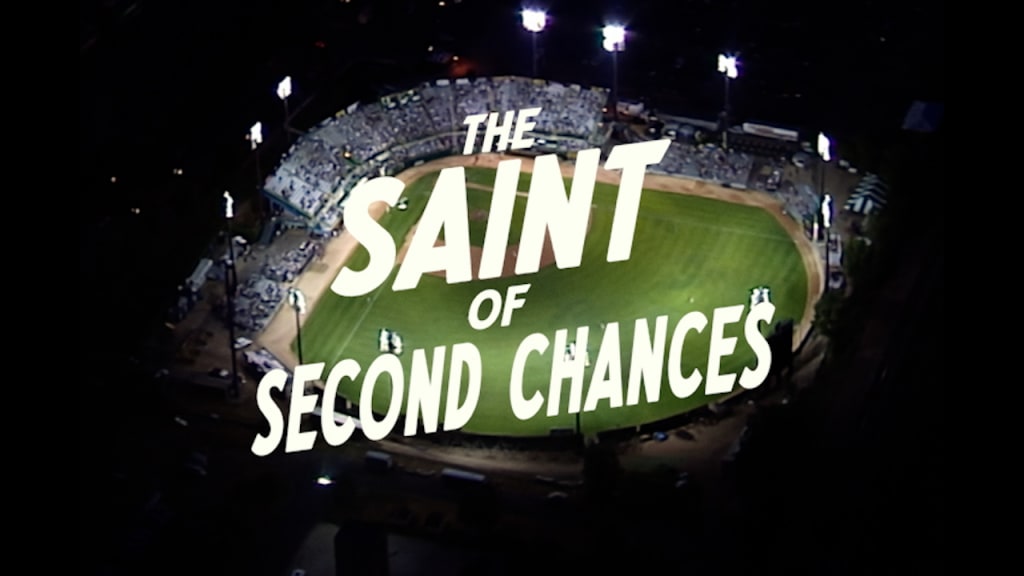Pitchometer? Stopwatch? How the Veecks first tried the pitch timer
This browser does not support the video element.
ST. PAUL, Minn. -- Thirty years before there was the pitch timer, urging along the modern Major League Baseball game and moving the sport away from a plodding pace, there was the stopwatch held in the hand of a Northern League ump.
The stopwatch’s use in a professional baseball game was the brainchild of Mike Veeck, himself the child of Bill Veeck -- a man with no shortage of brainchildren. Both Veecks wanted to put baseball on the clock, and both had timepieces that were, it turns out, not quite ready for prime time.
“Everything was great,” Mike says now of his stopwatch idea, “until we actually did it.”
Back in 1993, Mike was part of the ownership group of a new independent club called the St. Paul Saints -- a team that serves as the centerpiece of a Netflix documentary about the Veeck family entitled “The Saint of Second Chances.”
In true Veeck fashion, Mike had many creative marketing ideas to attract interest in a startup squad that would not only be playing in a decrepit old ballpark named Midway Stadium, but be doing so just six miles from the Metrodome, home to MLB’s Minnesota Twins (who, all these years later, now have the Saints as their Triple-A squad in the affiliated International League).
This browser does not support the video element.
The most notable of these ideas was a pig delivering baseballs to the umpire between innings. But while making baseball more boar-ing, Veeck, also wanted to make it less boring.
He wanted to speed games up.
And truth be told, he wanted something else.
“To prove I’m smarter than my dad,” he says before tilting his head back in an uproarious laugh.
So let’s flash back even further. You know Bill Veeck as the innovator who, as owner of the Cleveland Indians, St. Louis Browns and Chicago White Sox, improved fan interest with revolutionary promotional schemes, postgame fireworks, names on uniforms, etc.
But you might not know about his “Pitchometer.”
In Bill Veeck’s time, MLB was grappling with the beginnings of the pace problem. The advent of night baseball in 1935 had led pitchers to take more time between their offerings, because games played under the lights required them only to beat the other team -- not the sun. This led to a steady rise in average game time.
The rule allotting 20 seconds for a pitcher to deliver the ball with no one on base had been on the books since 1901. But it wasn’t until '55 that the Playing Rules Committee made any effort to enforce it. In Spring Training that year, umpires were equipped with stopwatches for exhibition games.
It, uh, didn’t really take. Umpires only peeked at the watches occasionally, so actual called violations were infrequent. The experiment did not last into the regular season.
Yet at a time when the 20-second rule was roundly ignored, the so-called “Barnum of Baseball” was definitely paying attention to it.
This browser does not support the video element.
In 1960, Bill Veeck, then the owner of the White Sox, unveiled one of his signature innovations -- Comiskey Park’s “exploding” scoreboard. The 130-foot-wide structure featured lights, sirens, a message board and multicolored pinwheels that would light up and spin as fireworks were set off when the Sox would hit a home run.
Tucked in the lower-left corner of the original exploding scoreboard was the Pitchometer.
Well, actually, what was there was the word, “Pitchometer.” The device itself never actually debuted.
But here, in his own words from his 1965 book “The Hustler’s Handbook,” is what Veeck had in mind for it:
A great portion of any ballgame consists of the pitcher holding the ball or throwing it to the catcher. Anything that can somehow turn that frozen tableau into a sense of drama and excitement has solved 75 percent of your problems.
According to the rules, when nobody is on base, the pitcher is supposed to deliver the ball within 20 seconds after he receives it. The Pitchometer was set up to tick off the seconds for us. When the hand hit the 20-second mark, it would actuate a siren that was guaranteed to knock the pitchers’ hat off and startle the boys in the downtown pool hall.
With luck, it would even call the umpire’s attention to the violations of the rule.
OK, so that’s just a little bit different -- and certainly louder -- than the pitch timer we have today. But you have to admire Veeck’s entertainment instincts and appreciation for pace.
This browser does not support the video element.
Alas, he goes on…
In any good promotion, timing is everything. I wanted to find the right pitcher to unveil the Pitchometer against, a pitcher who is particularly good and also particularly slow. You want to annoy, upset and even cow the opposing pitcher. But more than anything else, you want to surprise and delight the crowd. And, as in all gags, you want to make the rest of the world kick itself for not being there.
But before it was unveiled, I was out of baseball. It still sits there in the depths of Comiskey Park … complete with siren, like a leashed tiger, unheard, unseen.
Poor health compelled Veeck to sell his share of the team in 1961, and the Pitchometer idea was not resurrected when he returned to the South Side in the '70s.
But in a familiar refrain, the son took up the cause of the father.
This browser does not support the video element.
When Miles Wolff founded the Northern League in 1993 and Mike Veeck, Marv Goldklang, Van Schley and actor Bill Murray founded the St. Paul club, Veeck tried to sell Wolff on the idea of a clock.
“Miles,” Mike remembers saying, “we’ve got this covered!”
Veeck’s thought, identical to that 1955 Spring Training experiment, was to literally put the clock in the hands of the umpires and let them handle it.
But Wolff pushed back with a prediction.
“Games,” he told Veeck, “are going to take even longer.”
Though he was willing to experiment with a stopwatch in the nascent league, Wolff’s theory was that the Northern League’s umpires weren’t experienced -- and, therefore, respected -- enough to enforce the rule. He worried that offenders of the 20-second limit would spend so much time arguing with the ump that it would undermine the purpose of the timepiece.
And guess what? Wolff was absolutely right.
“It lasted about two pitches,” Veeck says with another big roar. “Holy God. Managers are out there and everybody’s arguing. Then the umpire’s hitting the stopwatch [on subsequent pitches] and going, ‘Hmm, the dugout’s going to empty here, and they’re all coming right for me!’”
The Veecks got a lot of great ideas off the ground over the years. The pitch timer, unfortunately, wasn’t one of them.
But now that timed baseball is a successful MLB reality, we can safely say the Veecks were ahead of their time.
“My dad would love [the pitch timer],” Veeck says. “He would have been proud that he pushed it, and he would have said, ‘This is what you have to do now.’ Because the kids and our attention spans are shorter. There’s much more information. He would say, ‘Kids are so much smarter than we are. They’re better informed. So let’s play to their strengths, rather than their weaknesses.’”

